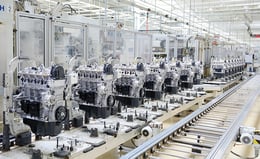Three Benefits of Digitizing Data
Nancy Sarpolis - May 10, 2022

A quality manager for a Midwest manufacturer recently voiced concern about the company’s ambitious digital transformation plans. The organization, she said, has data everywhere and in many different, disconnected formats—from spreadsheets to proprietary software systems to workers’ hard drives and even file cabinets. And, some of the data is in the form of institutional knowledge that has never been written down but lives only in the minds of long-tenured employees.
She has a point. The basis of a successful digital transformation is having complete and correct sets of data. Executives in every industry know that data is important, according to McKinsey, but for data to fuel an organization’s business initiatives, it must be readily available, of high quality and relevant.
1. Improved quality and accuracy
Data hygiene is a method of processing data to ensure it is relatively error free. It starts with identifying erroneous or incomplete data, reducing redundancies, and fixing or eliminating incorrect data. Some examples include duplicate data or columns, wrong values or constraint errors. In some cases, it might mean standardizing so numerical data use the same unit of measurement—such as converting miles to kilometers.
But many organizations find cleansing an overwhelming task, given the amount of data generated each day by machines, people and processes. It doesn’t have to be. According to McKinsey, prioritization should be made with an eye toward cleansing the data that fuel the most valuable use cases.
Clean data from IoT devices, RFID chips and other sources can be integrated into advanced planning and scheduling solutions. Importing large amounts of data from your infrastructure into a new software environment must be done in such a way that it can be extracted from multiple supply chain touchpoints quickly and easily anywhere on the supply chain.
Improved data quality helps provide more accurate, consistent and reliable information for decision-making in an organization. Another significant benefit of digitizing the manufacturing process is that digitized equipment is vastly more consistent than humans, with zero risk of human error.
Look for advanced planning solutions with validation tools that can identify deviations between actual data and its data definition language (DDL) description and provides reports or alerts for quick attention.
2. Better decision-making
Business operations and decision-making are increasingly data-driven, as organizations look to use data analytics to help improve business performance and gain competitive advantages over rivals. Making decisions with bad data, however, can lead to expensive mistakes. According to one global report, nearly 70% of organizations have made a significant business decision with inaccurate financial data.
Cloud-based solutions today offer more flexibility and integration tools that enable easier data collection, organization and analysis. Supply chain planners can manage computing capacity in a dynamic way, or employ a central solution that interworks easily with MES and ERP systems. The ability to integrate with Microsoft Azure, AWS or popular suppliers of cloud services can also result in fast, simple, and scalable implementation across the organization.
Cloud-based solutions also help reduce operating costs by streamlining automated processes and information and data storage and help break down functional silos and barriers to communication and collaboration.
3. Reduced costs
It’s estimated that that data quality issues cost organizations in the U.S. a total of $3.1 trillion. More than 81% of supply chain managers say that data analytics will be key to cost reduction in the future.
Advanced planning solutions can enable manufacturers to use their resources—materials, people or machines—more efficiently, leading to reduced manufacturing costs. Through planning and sequencing, manufacturers will know how many materials they need, which equipment should be used, and the most optimal times to produce specific products. As a result, no materials or labor are wasted, saving manufacturers significantly. In reducing waste, manufacturers substantially lower costs, maximizing the value of their production line.
Additionally, advanced planning capabilities also help manufacturers keep up with fluctuating demand, ensuring that they are not stuck with excess supply if demand drops. APS systems provide the insights to slot and schedule production lines according to accurately predicted demand, saving them from high and unpredicted manufacturing costs.
Going forward, digitally savvy organizations will use advanced planning solutions to maximize the value of their data and make decisions in real-time, whether it’s choosing the right order volumes from suppliers, making adjustments to a transport network, or setting production sequences in motion. Considering that these uncertain times have made resilience more important than ever, there’s no time to waste when it comes to putting supply chain data to use.
If you want to learn more get your Guide to Production Planning
In this Guide you will learn:
-
How to build resilience
-
How to increase efficiency
-
How to use integrated APS planning services for production planning
-
What must-have features of an APS solution you need
-
Which KPI’s you can expect
LATEST POSTS
- Understand Circular Economy in The Manufacturing Industry
- How Can Industry 4.0 IT Integration Be Achieved Smoothly?
- The Significance of Order Sequencing in Discrete Manufacturing
- How to improve your Supply Chain Management: The Power of Control Towers
- Optimizing Human Resource Scheduling in Manufacturing: A Technological Approach



